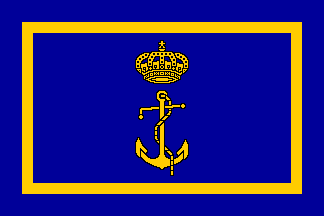 image by Miles Li, 27 March 2009
image by Miles Li, 27 March 2009
Last modified: 2021-01-01 by rob raeside
Keywords: italy |
Links: FOTW homepage |
search |
disclaimer and copyright |
write us |
mirrors
See also:
 image by Miles Li, 27 March 2009
image by Miles Li, 27 March 2009
Instituted by general order dated February 26th 1927. Hoisted
at the main to indicate the presence on board of the Minister of
the Navy, and at the bow of ships' launches and other minor
craft. To be saluted with 19 guns.
Ernesto Vitetti from www.regiamarina.net
The specifications for the flags are as follows:
- overall proportion, 20:30 (2:3)
- width of the yellow border, 1; distance to the border of the
flag, 2
- overall proportion of (crown + anchor), 5 x 12 for the
Minister's flag, 5 x15 for the Under Secretary's flag. In both
cases, the crown and anchor are centered vertically.
Ivan Sache, 2 December 2004
Previous Flag (1868-1893)
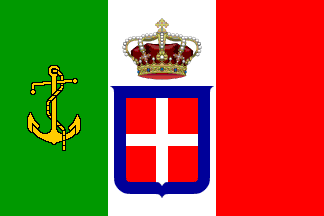 image by Miles Li, 30 December 2020
image by Miles Li, 30 December 2020
There is a special issue of 'Rivista Marittima' (no. 4 of
April 1992), written by Gino Galuppini and Franco Gay, title
'Insegne bandiere distintive e stemmi della Marina in Italia. Due
secoli di storia' (Ensigns, rank flags and arms of the Italian
Navy. Two centuries of history) [g2g92]. Between pages 24 and 28, the
brochure describes "Le insegne e bandiere distintive
addotate nel 1868' (Engigns and rank flags added in 1868):
Navy Minister (ministro della Marina) 1868-1893: national flag
with gold foul anchor on the green stripe.
The flag can be seen in a slightly different rendition - the Navy
minister has an unfouled anchor in the Hounsell flag book
"Flags and Signals of All Nations" (probably 1873): pp.
38-40 of the pdf file.
Jan Mertens, 30 December 2007
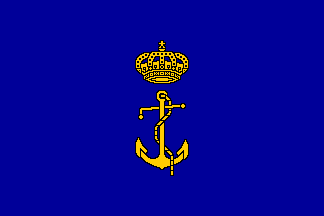 image by Miles Li, 27 December 2004
image by Miles Li, 27 December 2004
Same as the Minister of the Navy, but to be saluted by only 17
guns.
Ernesto Vitetti from www.regiamarina.net
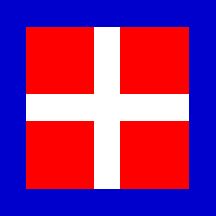 image by Ivan Sache, 29 April 2000
image by Ivan Sache, 29 April 2000
Square ensign with the Savoy cross (white on red) and a blue
border.
Source: Flaggenbuch [neu92].
Ivan Sache , 29 April 2000
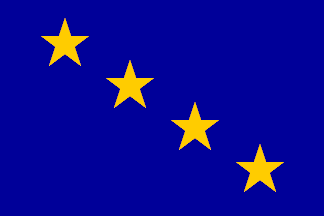 image by Miles Li, 21 December 2020
image by Miles Li, 21 December 2020
Rectangular (2:3) blue ensign with four five-pointed yellow
stars placed along the upper hoist-lower fly diagonal.
Now used by a Fleet Admiral.
Source: Flaggenbuch [neu92].
Ivan Sache , 29 April 2000
Admiral of the Fleet - Instituted by general order No. 291,
dated December 12th, 1926 and hoisted at the main to indicate the
presence on board of an Admiral of the Fleet and on the bow of
ships' launches and other minor craft. To be saluted with 19
guns. The
stars on the Admirals' flags were six-pointed, but
later changed to five points by a decree dated September
3rd, 1916.
Ernesto Vitetti from www.regiamarina.net
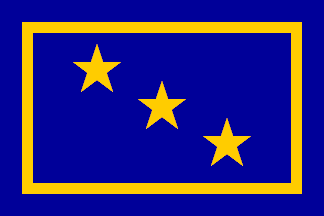 image by Miles Li, 21 December 2020
image by Miles Li, 21 December 2020
Same as Great Admiral, but with a yellow border inside the
flag. The number of stars (1 to 4) reflects the rank of the
officer
Still in use by the Chief of Naval
Staff (4 stars).
Source: Flaggenbuch [neu92].
Ivan Sache, 29 April 2000
Royal naval Chief of Staff (Note: the image is with 3
stars with the same kind of blue as other rank flags. ed.) -
Instituted by general order No. 78, dated March 19th 1917. The
number of stars displayed indicates the rank of the admiral.
Hoisted at the main or on the bow of ships' launches and other
minor craft. The stars on the Admirals' flags were
six-pointed, but later changed to five points by a decree
dated September 3rd, 1916
Ernesto Vitetti from www.regiamarina.net
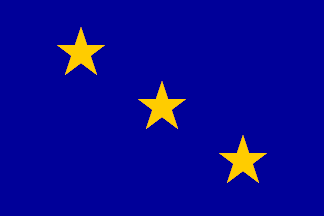 image by Miles Li, 21 December 2020
image by Miles Li, 21 December 2020
Rank flags during World War II:
Ammiraglio di armata - A blue flag with three yellow stars
arranged on an (imagined) line from the upper left to the lower
right corner.
Source: Jane's Fighting Ships of World War II
Marcus Wendel , 5 September 1999
Same as Great Admiral, but with only three stars. Still in use.
Source: Flaggenbuch [neu92].
Ivan Sache , 29 April 2000
Admiral (1st Class) - Instituted by general order No. 291
dated December 12th, 1926 and hoisted at the main to indicate the
presence on board of an Admiral or on the bow of ships' launches
and other minor craft. To be saluted with 17 guns. The stars on
the Admirals' flags were six-pointed, but later
changed to five points by a decree dated September 3rd, 1916
Ernesto Vitetti from www.regiamarina.net
Previous Flag (1868-1893)
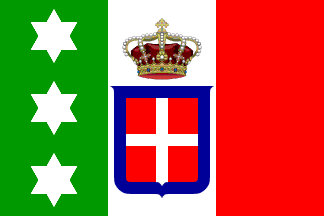 image by Miles Li, 30 December 2020
image by Miles Li, 30 December 2020
There is A special issue of 'Rivista Marittima' (no. 4 of
April 1992), written by Gino Galuppini and Franco Gay, title
'Insegne bandiere distintive e stemmi della Marina in Italia. Due
secoli di storia' (Ensigns, rank flags and arms of the Italian
Navy. Two centuries of history) [g2g92]. Between pages 24 and 28, the
brochure describes "Le insegne e bandiere distintive
addotate nel 1868' (Engigns and rank flags added in 1868):
Admiral (ammiraglio): national flag with three white six-pointed
stars placed vertically, and evenly, on the green stripe..
Jan Mertens, 30 December 2007
Flag at "Flags of Maritime Nations 1882"
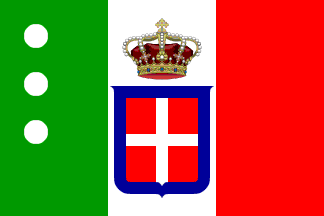 image by Miles Li, 31 December 2020
image by Miles Li, 31 December 2020
From the rank flags of the Royal Italian Navy as shown in the
US Navy publication "Flags of Maritime Nations
1882": Admiral had the naval ensign with three white
balls in the canton arranged vertically.
These rank flags were replaced with the blue bedsheet designs by
the time the next (1899) edition of "Flags of Maritime
Nations" was published.
Miles Li, 30 December 2007
1893-1916
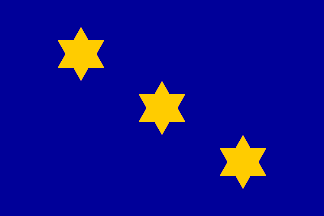 image by Miles Li, 1 January 2021
image by Miles Li, 1 January 2021
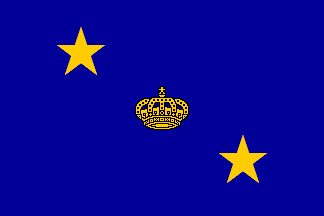 image by Miles Li, 28 December 2020
image by Miles Li, 28 December 2020
Rank flags during World War II:
Ammiraglio di squarda - The same as above but with the middle
star replaced by a crown.
Source: Jane's Fighting Ships of World War II
Marcus Wendel , 5 September 1999
Vice-Admiral (1st Class) - Instituted by general order No. 87
dated April 13th, 1939. Hoisted at the main to indicate the
presence on board of a Vice Admiral or on the bow of ships'
launches and other minor craft. To be saluted with 15 guns. The stars on the
Admirals' flags were six-pointed, but later changed
to five points by a decree dated September 3rd, 1916
Ernesto Vitetti from www.regiamarina.net
Previous Flag (1868-1893)
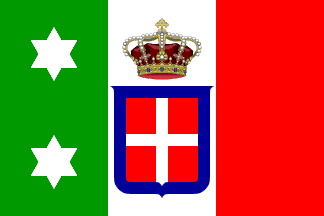 image by Miles Li, 30 December 2020
image by Miles Li, 30 December 2020
There is A special issue of 'Rivista Marittima' (no. 4 of
April 1992), written by Gino Galuppini and Franco Gay, title
'Insegne bandiere distintive e stemmi della Marina in Italia. Due
secoli di storia' (Ensigns, rank flags and arms of the Italian
Navy. Two centuries of history) [g2g92]. Between pages 24 and 28, the
brochure describes "Le insegne e bandiere distintive
addotate nel 1868' (Engigns and rank flags added in 1868):
Vice Admiral (viceammiraglio): as above with two stars,
distributed evenly.
Jan Mertens, 30 December 2007
Flag at "Flags of Maritime Nations 1882"
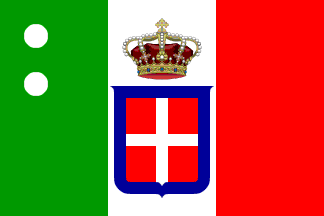 image by Miles Li, 31 December 2020
image by Miles Li, 31 December 2020
From the rank flags of the Royal Italian Navy as shown in the
US Navy publication "Flags of Maritime Nations
1882": Vice Admiral had the naval ensign with two
white balls in the canton arranged vertically.
These rank flags were replaced with the blue bedsheet designs by
the time the next (1899) edition of "Flags of Maritime
Nations" was published.
Miles Li, 30 December 2007
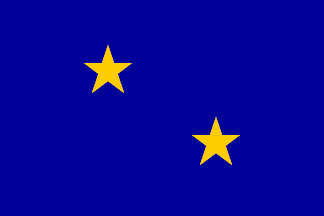 image by Miles Li, 21 December 2020
image by Miles Li, 21 December 2020
Rank flags during World War II:
Ammiralgio di divisione - The same as above but with only two
stars.
Source: Jane's Fighting Ships of World War II
Marcus Wendel , 5 September 1999
Same as Admiral, but with only two stars. Still in use.
Source: Flaggenbuch [neu92].
Ivan Sache , 29 April 2000
Vice-Admiral (2nd Class) - Instituted by general order No. 291
dated December 12th, 1926 and hoisted at the main to indicate the
presence on board of a Rear Admiral or on the bow of ships'
launches and other minor craft. To be saluted with 13 guns. The
stars on the Admirals' flags were six-pointed, but
later changed to five points by a decree dated September
3rd, 1916
Ernesto Vitetti from www.regiamarina.net
1893-1916
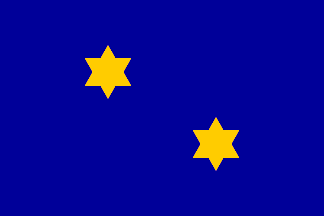 image by Miles Li, 1 January 2021
image by Miles Li, 1 January 2021
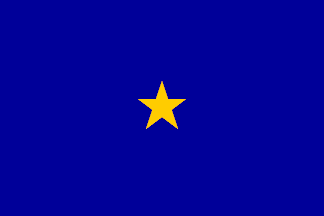 image by Miles Li, 21 December 2020
image by Miles Li, 21 December 2020
Rank flags during World War II:
Contrammiraglio - A blue flag with a centered yellow star .
Source: Jane's Fighting Ships of World War II
Marcus Wendel , 5 September 1999
Same as Admiral, but with only one star. Still in use.
Source: Flaggenbuch [neu92].
Ivan Sache , 29 April 2000
Instituted by general order No. 291 dated December 12th, 1926
and hoisted at the main to indicate the presence on board of a
Rear Admiral or on the bow of ships' launches and other minor
craft. To be saluted with 11 guns. The stars on the
Admirals' flags were six-pointed, but later changed
to five points by a decree dated September 3rd, 1916
Ernesto Vitetti from www.regiamarina.net
Previous Flag (1868-1893)
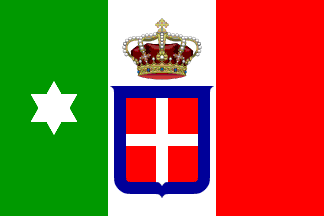 image by Miles Li, 30 December 2020
image by Miles Li, 30 December 2020
There is A special issue of 'Rivista Marittima' (no. 4 of
April 1992), written by Gino Galuppini and Franco Gay, title
'Insegne bandiere distintive e stemmi della Marina in Italia. Due
secoli di storia' (Ensigns, rank flags and arms of the Italian
Navy. Two centuries of history) [g2g92]. Between pages 24 and 28, the
brochure describes "Le insegne e bandiere distintive
addotate nel 1868' (Engigns and rank flags added in 1868):
Rear Admiral (contrammiraglio): as above with one star, placed in
the centre of the green stripe.
Jan Mertens, 30 December 2007
Flag at "Flags of Maritime Nations 1882"
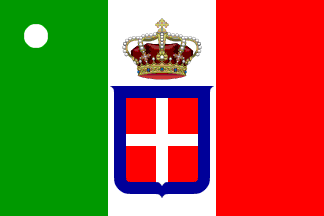 image by Miles Li, 31 December 2020
image by Miles Li, 31 December 2020
From the rank flags of the Royal Italian Navy as shown in the
US Navy publication "Flags of Maritime Nations
1882": Rear Admiral had the naval ensign with one
white ball in the canton arranged vertically.
These rank flags were replaced with the blue bedsheet designs by
the time the next (1899) edition of "Flags of Maritime
Nations" was published.
Miles Li, 30 December 2007
1893-1916
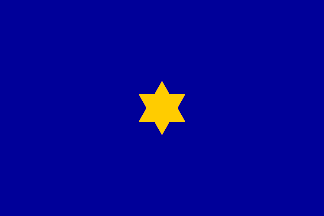 image by Miles Li, 1 January 2021
image by Miles Li, 1 January 2021
 image by Ivan Sache, 11 March 2000
image by Ivan Sache, 11 March 2000
Plain blue forked ensign. Still in
use.
Source: Flaggenbuch [neu92].
Ivan Sache , 29 April 2000
Captain commanding a naval division - Instituted by Royal
Decree dated September 20th, 1882 hoisted at the main to indicate
the presence on board of the Senior Captain, should several ships
lie at anchor without a Flag being hoisted on any of them.
Ernesto Vitetti from www.regiamarina.net
Previous Flag (1868-1893)
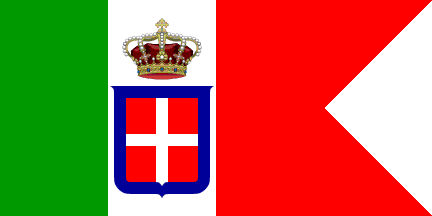 image by Miles Li, 30 December 2020
image by Miles Li, 30 December 2020
There is A special issue of 'Rivista Marittima' (no. 4 of
April 1992), written by Gino Galuppini and Franco Gay, title
'Insegne bandiere distintive e stemmi della Marina in Italia. Due
secoli di storia' (Ensigns, rank flags and arms of the Italian
Navy. Two centuries of history) [g2g92]. Between pages 24 and 28, the
brochure describes "Le insegne e bandiere distintive
addotate nel 1868' (Engigns and rank flags added in 1868):
Capitani di vascello - National flag ending in a swallowtail, the
red stripe being twice as large (measured at the horizontal
edges) as the others.
Jan Mertens, 30 December 2007
Flag at "Flags of Maritime Nations 1882"
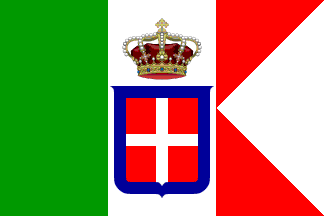 image by Miles Li, 31 December 2020
image by Miles Li, 31 December 2020
From the rank flags of the Royal Italian Navy as shown in the
US Navy publication "Flags of Maritime Nations
1882": Captain in command had a broad pennant, i.e.
swallowed tailed version of the naval ensign, although the book
captioned it as that of a "commodore", a rank which has
never existed in the Italian Navy!
These rank flags were replaced with the blue bedsheet designs by
the time the next (1899) edition of "Flags of Maritime
Nations" was published.
Miles Li, 30 December 2007
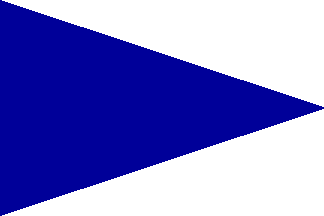 image by Ivan Sache ,13 July 1999
image by Ivan Sache ,13 July 1999
Plain blue pennant. Still in use.
Source: Flaggenbuch [neu92].
Ivan Sache , 29 April 2000
Instituted by a general order dated September 11th, 1913 and
hoisted at the foremast to indicate, should several destroyers or
submarines come together, which ship has on board the senior
officer.
Ernesto Vitetti from www.regiamarina.net
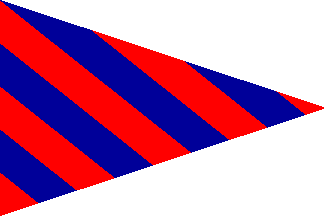 image by Ivan Sache, 13 July 1999
image by Ivan Sache, 13 July 1999
Pennant with ten alternating red and blue diagonal (upper
hoist-lower fly) stripes.
Now used by a commodore commanding a
flotilla.
Source: Flaggenbuch [neu92].
Ivan Sache , 29 April 2000
Commander of a light units flotilla - Instituted by a general
order dated June 8th 1923 and hoisted at the foremast to indicate
the Commander of a Flotilla of any type of small units:
destroyers, torpedo boats, submarines, PT boats, etc.
Ernesto Vitetti from www.regiamarina.net
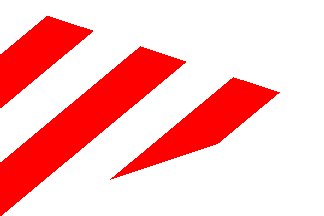 image by Ivan Sache , 13 July 1999
image by Ivan Sache , 13 July 1999
Pennant with seven alternating white and red diagonal (lower
hoist-upper fly) stripes.
Now used by a captain commanding a
flotilla.
Source: Flaggenbuch [neu92].
Ivan Sache , 29 April 2000
Commander of a destroyers flotilla - Instituted by general
order dated April 21st, 1904 and hoisted at the foremast to
indicate the Commander of a formation of Destroyers.
Ernesto Vitetti from www.regiamarina.net
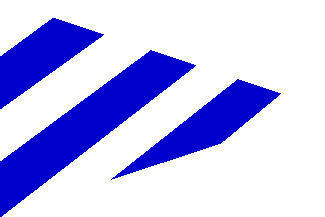 image by Ivan Sache , 29 April 2000
image by Ivan Sache , 29 April 2000
Same with blue stripes instead of red.
Source: Flaggenbuch [neu92].
Ivan Sache , 29 April 2000
Commander of a torpedo boats flotilla - Instituted by a
general order dated September 11th, 1913 and hoisted at the
foremast to indicate the Commander of a formation of torpedo
boats.
Ernesto Vitetti from www.regiamarina.net
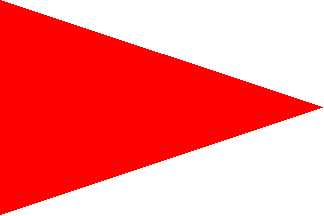 image by Ivan Sache , 29 April 2000
image by Ivan Sache , 29 April 2000
Plain red pennant.
Source: Flaggenbuch [neu92].
Ivan Sache , 29 April 2000
Commander of a submarines flotilla - Instituted by general
order dated June 8th 1923 and hoisted to indicate the Commander
of a formation of Submarines.
Ernesto Vitetti from www.regiamarina.net
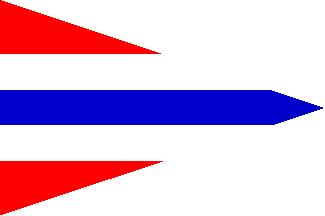 image by Ivan Sache , 29 April 2000
image by Ivan Sache , 29 April 2000
Pennant with five horizontal stripes,
red-white-blue-white-red.
Source: Flaggenbuch [neu92].
Ivan Sache , 29 April 2000
Commander of a group of motor torpedo boats (M.A.S.) (PT
boats) - Instituted by general order dated June 8th 1923 and
hoisted to indicate the Commander of a formation of PT boats.
Ernesto Vitetti from www.regiamarina.net
General Officers of the Technical Corps of the Navy hoisted
white flags with red stars, like generals of the Army. By general
order No. 23 dated March 18th, 1944, they were granted the same
blue flags as the Admirals, but with white stars instead of the
yellow ones.
Ernesto Vitetti from www.regiamarina.net
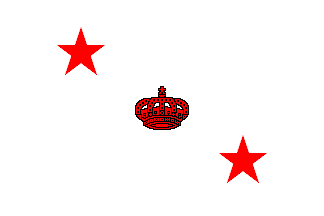 image by Miles Li, 28 December 2020
image by Miles Li, 28 December 2020
based on
www.regiamarina.net
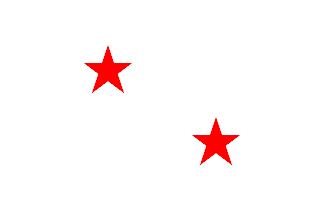 image by Miles Li, 22 December 2020
image by Miles Li, 22 December 2020
based on
www.regiamarina.net
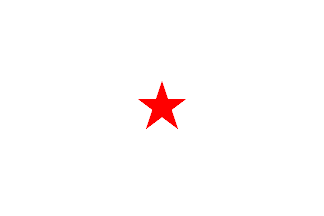 image by Miles Li, 22 December 2020
image by Miles Li, 22 December 2020
based on www.regiamarina.net